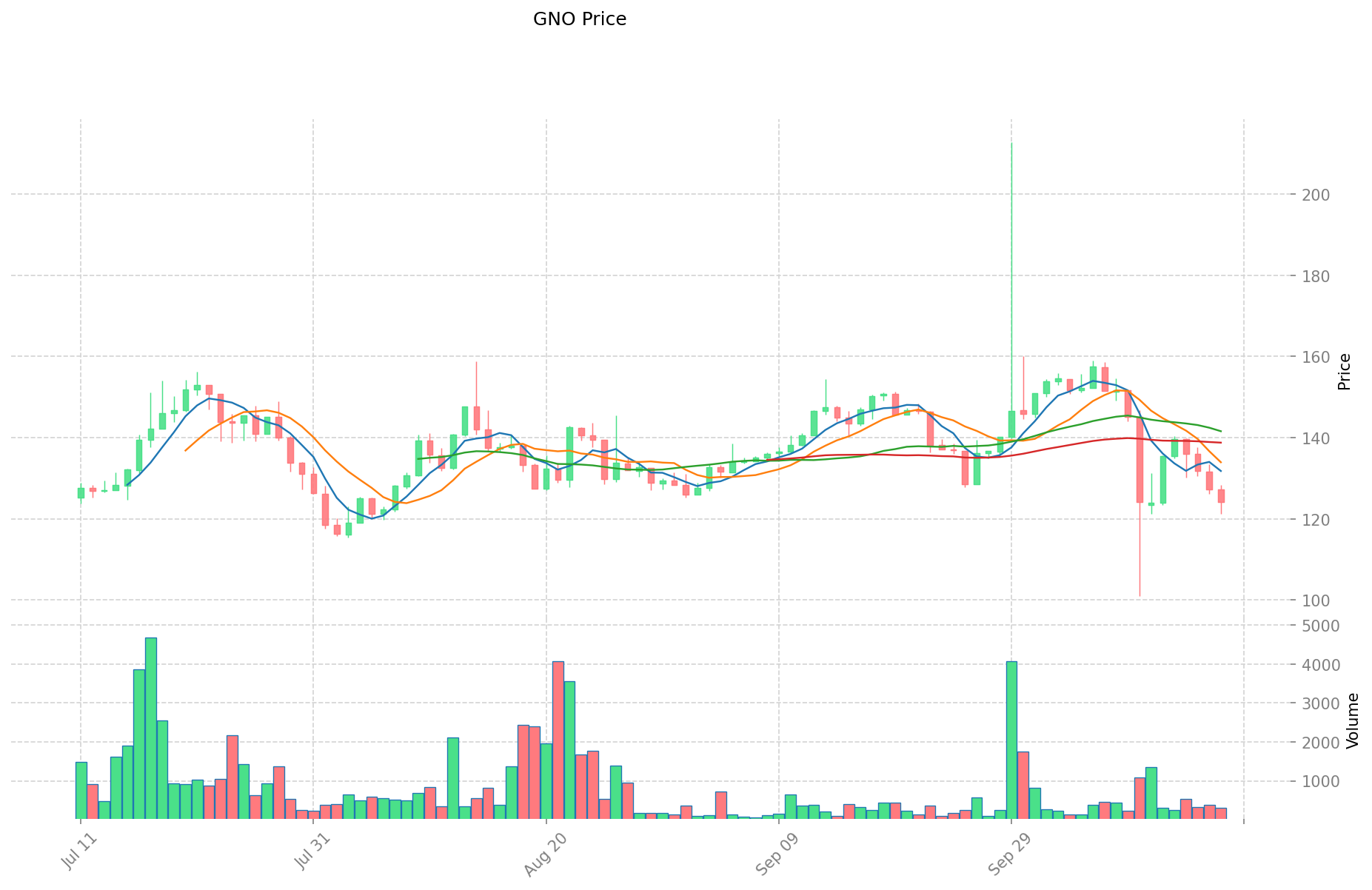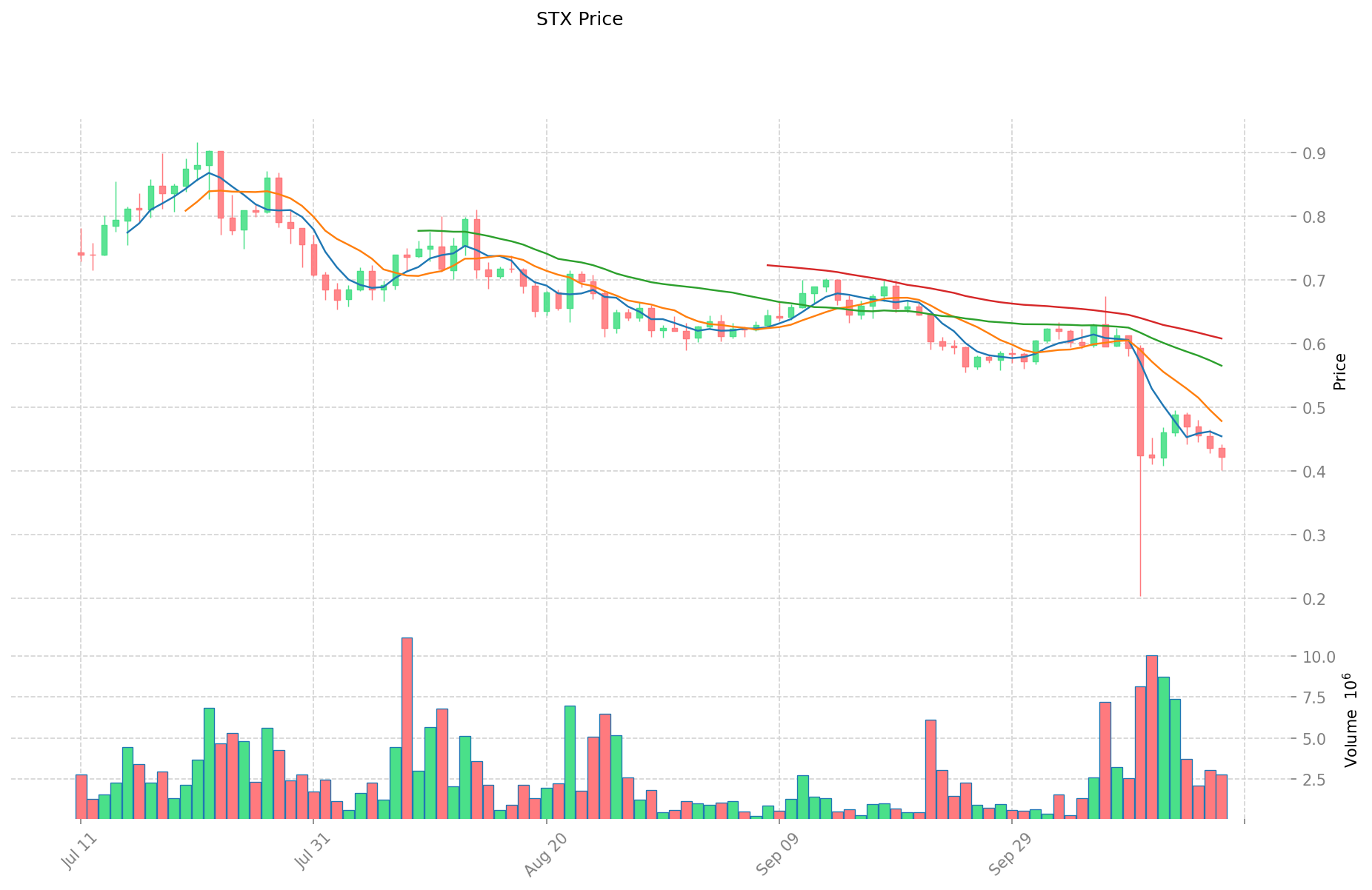GNO vs STX: Akıllı Sözleşme Geliştirmede İki Blockchain Ekosisteminin Karşılaştırılması

Giriş: GNO ve STX'in Yatırım Karşılaştırması
Kripto para piyasasında, Gnosis (GNO) ile Stacks (STX) arasındaki karşılaştırma yatırımcılar için sıkça tartışılan bir başlıktır. Bu iki varlık, hem piyasa değeri sıralaması, uygulama alanları ve fiyat performansı açısından dikkat çekici farklılıklara sahip hem de kripto varlık ekosisteminde ayrı konumları temsil eder.
Gnosis (GNO): 2017'de piyasaya sürülen Gnosis, merkeziyetsiz tahmin piyasası platformuyla sektörün dikkatini çekmiştir.
Stacks (STX): 2019'da tanıtılan Stacks, merkeziyetsiz uygulamalar için yeni nesil internet olarak tanımlanmakta ve kullanıcıların verileri üzerindeki denetimini artırmayı hedeflemektedir.
Bu makalede; GNO ve STX'in yatırım değerleri, geçmiş fiyat hareketleri, arz mekanizmaları, kurumsal benimseme, teknolojik ekosistemler ve gelecek projeksiyonları üzerinden kapsamlı biçimde analiz edilerek yatırımcıların aklındaki en kritik soruya yanıt aranacaktır:
"Şu anda hangisi daha avantajlı bir yatırım?"
I. Fiyat Geçmişi Karşılaştırması ve Güncel Piyasa Durumu
GNO (Coin A) ve STX (Coin B) Tarihsel Fiyat Hareketleri
- 2021: GNO, 9 Kasım 2021'de 644,2 dolar ile zirve noktası gördü.
- 2024: STX, 1 Nisan 2024'te 3,86 dolar ile en yüksek seviyesini kaydetti.
- Kıyaslama: GNO, zirve noktası olan 644,2 dolardan 124,2 dolara gerilerken; STX, 3,86 dolardan 0,422 dolara düştü.
Güncel Piyasa Durumu (18 Ekim 2025)
- GNO güncel fiyatı: 124,2 dolar
- STX güncel fiyatı: 0,422 dolar
- 24 saatlik işlem hacmi: GNO 39.446.529 dolar, STX 1.159.952.922991 dolar
- Piyasa Duyarlılık Endeksi (Korku & Açgözlülük Endeksi): 22 (Aşırı Korku)
Canlı fiyatları görmek için tıklayın:
- GNO güncel fiyatı için Piyasa Fiyatı
- STX güncel fiyatı için Piyasa Fiyatı


II. GNO ve STX'in Yatırım Değerini Etkileyen Temel Unsurlar
Arz Mekanizmaları (Tokenomik)
- GNO: 10 milyon token ile sabit arz tavanı, yaklaşık 2,5 milyon token dolaşımda
- STX: Zamanla azalan blok ödülleriyle öngörülebilir arz programı
- 📌 Tarihsel Eğilim: GNO gibi sınırlı arzlı kripto paralar boğa piyasalarında kıtlık nedeniyle değer kazanırken, STX'in azalan enflasyon modeli ise uzun vadeli değer koruması sağlar.
Kurumsal Benimseme ve Piyasa Uygulamaları
- Kurumsal Varlık: STX, Stacks ekosistemiyle Bitcoin üzerinde inşa edilen projeler sayesinde daha fazla kurumsal talep gördü
- Kurumsal Benimseme: GNO, DeFi altyapısı ve yönetişime odaklanırken; STX, Bitcoin üzerinde akıllı sözleşme imkanını sunar
- Düzenleyici Durum: İki proje de farklı ülkelerde çeşitli düzenleyici ortamlara tabi. STX'in Bitcoin ile bağlantısı, bazı yasal açılardan avantaj sağlayabilir
Teknoloji Gelişimi ve Ekosistem Oluşturma
- GNO Teknoloji Güncellemeleri: Ethereum L2 çözümleriyle entegrasyon ve Gnosis Protocol'ün DeFi uygulamaları için sürekli geliştirilmesi
- STX Teknoloji Gelişimi: Nakamoto yükseltmesiyle Stacks'e Bitcoin kesinliği kazandırıldı ve sBTC fonksiyonu etkinleştirildi
- Ekosistem Karşılaştırması: GNO, tahmin piyasaları ve DAO yönetim araçlarında önde; STX ise Bitcoin tabanlı DeFi ve NFT altyapısını inşa ediyor
Makroekonomik Unsurlar ve Piyasa Döngüleri
- Enflasyon Performansı: Her iki token da sınırlı arz mekanizması ile enflasyona karşı koruma potansiyeli taşır
- Makro Para Politikası: Faiz oranı değişiklikleri, GNO ve STX dahil tüm kripto piyasasında etkili olur
- Jeopolitik Etkiler: Bitcoin bağlantılı varlıklar olan STX, ekonomik belirsizlik dönemlerinde küresel Bitcoin adaptasyonundan olumlu etkilenebilir
III. 2025-2030 Fiyat Tahmini: GNO vs STX
Kısa Vadeli Tahmin (2025)
- GNO: Muhafazakâr 98,12 - 124,20 dolar | İyimser 124,20 - 178,85 dolar
- STX: Muhafazakâr 0,28 - 0,42 dolar | İyimser 0,42 - 0,50 dolar
Orta Vadeli Tahmin (2027)
- GNO'nun büyüme fazına girmesiyle tahmini fiyat aralığı: 161,66 - 189,18 dolar
- STX'in konsolidasyon fazında olmasıyla tahmini fiyat aralığı: 0,28 - 0,73 dolar
- Kilit etkenler: Kurumsal girişler, ETF gelişmeleri, ekosistem büyümesi
Uzun Vadeli Tahmin (2030)
- GNO: Temel senaryo 169,36 - 256,60 dolar | İyimser senaryo 256,60 - 338,72 dolar
- STX: Temel senaryo 0,42 - 0,77 dolar | İyimser senaryo 0,77 - 0,98 dolar
Feragatname
GNO:
| 年份 | 预测最高价 | 预测平均价格 | 预测最低价 | 涨跌幅 |
|---|---|---|---|---|
| 2025 | 178.848 | 124.2 | 98.118 | 0 |
| 2026 | 192.43548 | 151.524 | 80.30772 | 22 |
| 2027 | 189.177714 | 171.97974 | 161.6609556 | 38 |
| 2028 | 261.83915415 | 180.578727 | 157.10349249 | 45 |
| 2029 | 291.995801559 | 221.208940575 | 123.877006722 | 78 |
| 2030 | 338.71512980844 | 256.602371067 | 169.35756490422 | 106 |
STX:
| 年份 | 预测最高价 | 预测平均价格 | 预测最低价 | 涨跌幅 |
|---|---|---|---|---|
| 2025 | 0.498196 | 0.4222 | 0.278652 | 0 |
| 2026 | 0.58445146 | 0.460198 | 0.34975048 | 9 |
| 2027 | 0.7260313747 | 0.52232473 | 0.2820553542 | 23 |
| 2028 | 0.736530101773 | 0.62417805235 | 0.5055842224035 | 47 |
| 2029 | 0.864049677868105 | 0.6803540770615 | 0.62592575089658 | 61 |
| 2030 | 0.980696384380299 | 0.772201877464802 | 0.424711032605641 | 82 |
IV. Yatırım Stratejisi Karşılaştırması: GNO ve STX
Uzun Vadeli ve Kısa Vadeli Yatırım Stratejileri
- GNO: DeFi altyapısı ve DAO yönetimine odaklanan yatırımcılar için uygun
- STX: Bitcoin tabanlı akıllı sözleşmeler ve merkeziyetsiz uygulamalarla ilgilenenler için uygun
Risk Yönetimi ve Varlık Dağılımı
- Temkinli yatırımcılar için: GNO %30 - STX %70
- Daha agresif profiller için: GNO %60 - STX %40
- Koruma araçları: Stablecoin tahsisi, opsiyon işlemleri, çoklu para portföyleri
V. Potansiyel Risk Karşılaştırması
Piyasa Riskleri
- GNO: Sınırlı işlem hacmi ve piyasa değeri nedeniyle dalgalanma riski
- STX: Bitcoin piyasası performansı ve benimsenmesine bağlılık
Teknik Riskler
- GNO: Ölçeklenebilirlik ve ağ istikrarı
- STX: Madencilikte merkezileşme ve güvenlik açıkları
Düzenleyici Riskler
- Küresel düzenleyici politikalar, iki token üzerinde farklı etkiler yaratabilir
VI. Sonuç: Hangi Token Daha Avantajlı?
📌 Yatırım Değeri Özeti:
- GNO'nun avantajları: Sabit arz, tahmin piyasalarında ve DAO araçlarında güçlü konum
- STX'in avantajları: Bitcoin tabanlı akıllı sözleşmeler, kurumsal benimsenme, azalan enflasyon modeli
✅ Yatırım Tavsiyesi:
- Yeni yatırımcılar: Bitcoin bağlantısı nedeniyle STX'e biraz daha ağırlık veren dengeli bir portföy düşünmeli
- Deneyimli yatırımcılar: Kendi risk profillerine göre iki ekosistemde de fırsatları değerlendirmeli
- Kurumsal yatırımcılar: Her iki tokenı da çeşitlendirilmiş kripto portföyüne dahil etme potansiyelini analiz etmeli
⚠️ Risk Uyarısı: Kripto para piyasası yüksek volatiliteye sahip olup bu makaledeki bilgiler yatırım tavsiyesi değildir. None
VII. SSS
S1: GNO ve STX arasındaki ana farklar nelerdir? C: GNO, merkeziyetsiz tahmin piyasaları ve DeFi altyapısına odaklanırken; STX, Bitcoin üzerinde akıllı sözleşme fonksiyonu sunar. GNO'nun toplam arzı 10 milyon ile sınırlı, STX ise zamanla azalan blok ödüllerine dayalı öngörülebilir bir arz programına sahiptir.
S2: Geçmişte hangi token daha iyi performans gösterdi? C: GNO, Kasım 2021'de 644,2 dolara, STX ise Nisan 2024'te 3,86 dolara ulaştı. Her ikisi de zirvelerinden gerilerken, güncel olarak GNO 124,2 dolar, STX ise 0,422 dolar seviyesindedir.
S3: GNO ve STX'in arz mekanizmaları nasıl farklılık gösteriyor? C: GNO'nun toplam arzı 10 milyon ve yaklaşık 2,5 milyon token dolaşımda. STX ise zamanla azalan blok ödülleriyle öngörülebilir bir arz yapısına sahip; bu mekanizma uzun vadeli değer koruması sağlar.
S4: GNO ve STX'in yatırım değerini etkileyen temel unsurlar hangileridir? C: Arz mekanizmaları, kurumsal benimseme, piyasa uygulamaları, teknoloji gelişimi, ekosistem oluşturma, makroekonomik etkenler ve piyasa döngüleri öne çıkmaktadır.
S5: GNO ve STX için uzun vadeli fiyat öngörüleri nelerdir? C: 2030 yılına kadar, GNO'nun 169,36 - 338,72 dolar, STX'in ise 0,42 - 0,98 dolar aralığına ulaşması beklenmektedir.
S6: Yatırımcılar portföylerini GNO ve STX arasında nasıl dağıtmalı? C: Temkinli yatırımcılar için GNO %30, STX %70; agresif yatırımcılar için GNO %60, STX %40 dağılımı düşünülebilir. Nihai karar bireysel risk iştahına ve hedeflere göre verilmelidir.
S7: GNO ve STX yatırımlarında hangi risklerle karşılaşılabilir? C: Her iki token da volatilite, teknik sorunlar (ölçeklenebilirlik, güvenlik açıkları) ve küresel düzenleyici değişiklikler gibi risklerle karşı karşıyadır. GNO, düşük işlem hacminden daha çok etkilenirken, STX'in performansı ise Bitcoin piyasası ve benimsemesiyle doğrudan ilişkilidir.

2025 BARD Fiyat Tahmini: Google'un yapay zeka sohbet botu için potansiyel büyüme ve piyasa trendlerinin analizi

2025 ECHO Fiyat Tahmini: ECHO Token'ın Büyüme Potansiyeli ve Piyasa Trendleri Analizi

Gate Wrapped BTC (GTBTC) iyi bir yatırım mı?: Bu kripto para türevinin riskleri ile potansiyel getirilerini değerlendiriyoruz

2025 ROCK Fiyat Tahmini: Kripto Para Birimi Piyasasındaki Trendler ve Olası Büyüme Faktörlerinin Değerlendirilmesi

2025 ALEX Fiyat Tahmini: Merkeziyetsiz Borsa Tokeninde Yükselen Eğilimler ve Büyümeyi Harekete Geçiren Temel Unsurlar

TAPPROTOCOL ve TRX: Merkeziyetsiz uygulamalar için iki blockchain platformunu karşılaştırma

Dropee Günlük Kombinasyonu 11 Aralık 2025

Tomarket Günlük Kombinasyonu 11 Aralık 2025

Merkeziyetsiz Finans'ta Geçici Kayıp Nedir?

Kripto Parada Çifte Harcama: Önleme Stratejileri

Kripto Ticaretinde Wyckoff Yönteminin Anlaşılması





